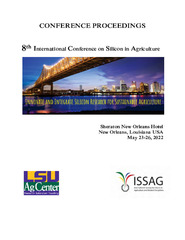Приказ основних података о документу
Effect of N-forms on Silicon Mobilization in the Rhizosphere of White Lupin
| dc.creator | Kostić Kravljanac, Ljiljana | |
| dc.creator | Trailović, Maja | |
| dc.creator | Pavlović, Jelena | |
| dc.creator | Kostić, Igor | |
| dc.creator | Dubljanin, Tijana | |
| dc.creator | Nikolic, Miroslav | |
| dc.date.accessioned | 2023-10-04T06:28:08Z | |
| dc.date.available | 2023-10-04T06:28:08Z | |
| dc.date.issued | 2022 | |
| dc.identifier.uri | http://rimsi.imsi.bg.ac.rs/handle/123456789/2135 | |
| dc.description.abstract | Silicon (Si) is the major constituent of soil present in various fractions, i.e., mobile, adsorbed, occluded (in pedogenic oxides and hydroxides), amorphous (biogenic and lithogenic) and crystalline (primary and secondary silicates, and quartz). Different soil factors such as pH, temperatures, microbial activity, the presence of cations, Al/Fe oxides and hydroxides and organic compounds, influence Si transformation, thereby modifying plant availably of Si. Silicon mobility and transformation in the soil have mainly been studied in the context of pedogenesis or biogeochemical Si cycling. However, research on Si mobility, transformation, and plant availability in the rhizosphere is still lacking. Here, we investigated the root potential of white lupine (Lupinus albus L.), known as a phosphorus (P)-efficient model plant (e.g., root release of H+ and carboxylates), to mobilize Si from the soil. Plants were grown in the rhizoboxes filled with low P soil (control) and fertilized with different N-forms (NO3, NH4 and NO3NH4). The control, NO3- and NO3NH4-fertilized plants accumulated significantly lower amounts of Si than the NH4-fertilized ones. All applied N-forms influenced Si availability in the bulk soil, but Si fractions have further been modified in the rhizosphere, what was crucial for Si accumulation in plants. For instance, NO3 supply slightly decreased Si availability in the bulk soil, but lupine plants accumulated a similar amount of Si as the control plants. A strong gradient of decreasing Si concentrations between bulk and rhizosphere soils was observed in mobile, adsorbed, and amorphous biogenic Si pools in the control and in all N treatments, while occluded and lithogenic amorphous Si pools were recalcitrant. Interestingly, a gradient of increasing concentrations of the amorphous biogenic Si pool between bulk and rhizosphere soils was recorded in the NH4 treatment, concomitantly with the strongest rhizosphere acidification. | sr |
| dc.language.iso | en | sr |
| dc.publisher | ISSAG and AgCenter LSU | sr |
| dc.rights | openAccess | sr |
| dc.rights.uri | https://creativecommons.org/licenses/by/4.0/ | |
| dc.source | 8th International Conference on Silicon in Agriculture, May 23-26, 2022, New Orleans, LA, USA | sr |
| dc.subject | Biogeochemical cycling, Biogenic silicon, Phosphorus-efficient plant | sr |
| dc.title | Effect of N-forms on Silicon Mobilization in the Rhizosphere of White Lupin | sr |
| dc.type | conferenceObject | sr |
| dc.rights.license | BY | sr |
| dc.identifier.fulltext | http://rimsi.imsi.bg.ac.rs/bitstream/id/5674/bitstream_5674.pdf | |
| dc.identifier.rcub | https://hdl.handle.net/21.15107/rcub_rimsi_2135 | |
| dc.type.version | publishedVersion | sr |

